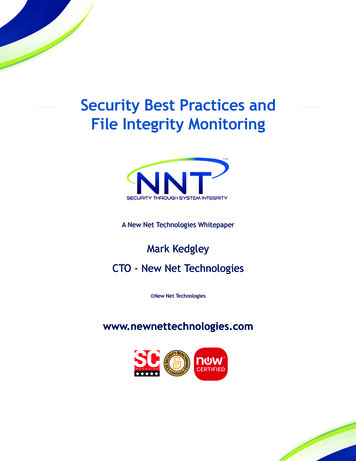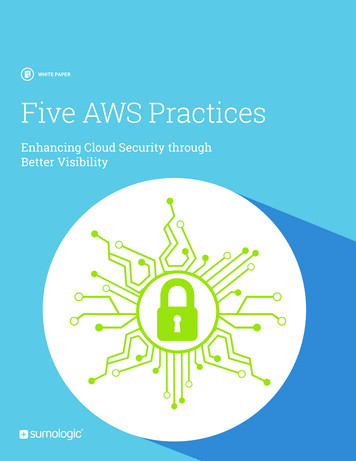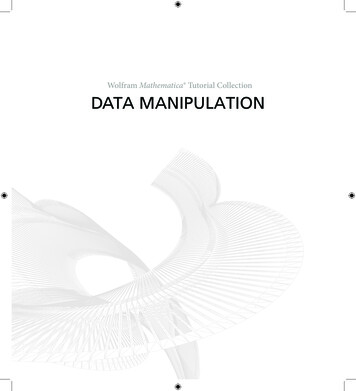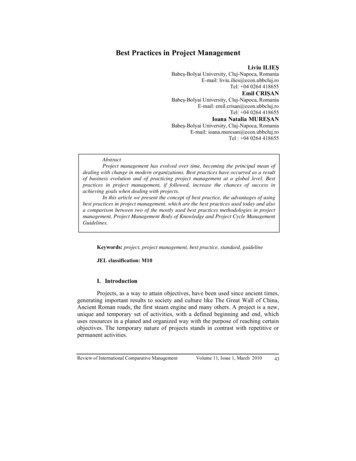
Transcription
Security Best Practices andFile Integrity MonitoringA New Net Technologies WhitepaperMark KedgleyCTO - New Net Technologies New Net Technologieswww.newnettechnologies.com
Security Best Practices and File Integrity Monitoring WhitepaperAbstract“Security is a complex area - there are many types of cyber threat to deal withand each requires a different set of tactics and capabilities. Whether you need toprotect your organizations confidential data - be it intellectual property or yourcustomers’ personal information - or fend off malicious attacks and acts of internet vandalism, the threats are out there and getting increasingly tough to defendagainst.the term ‘file integrity monitoring’ is onlymentioned in [PCI DSS]requirement 11.5, onecould be forgiven forconcluding that this isthe only part FIM has toplay within the PCI DSS”This whitepaper brings together a number of topics originally covered in the NNTBlog, explaining what the various threats are and how file integrity monitoring cannot only detect malware that may otherwise remain invisible, but also be used toprovide an effective, preventative security strategy.View Security Incidents in Black and White? Or Glorious Technicolor?Using FIM, or file integrity monitoring, has long been established as a keystone of information security best practices. Even so, there are still a number of common misunderstandings about why FIM is important and what it can deliver. Ironically, the key contributor to this confusion is the same security standard that introduces most people to FIM inthe first place by mandating the use of it – the PCI DSS. FIM is an integral line of defensein all major security standards, but we will reference the PCI DSS to illustrate this particular discussion.PCI DSS Requirement 11.5 specifically uses the term ‘file integrity monitoring’ in relation to the need to “alert personnel to unauthorized modification of critical system files,configuration files, or content files; and configure the software to perform critical filecomparisons at least weekly”As such, since the term ‘file integrity monitoring’ is only mentioned in requirement 11.5,one could be forgiven for concluding that this is the only part FIM has to play within thePCI DSS.In fact, the application of FIM is and should be much more widespread in underpinninga solid secure posture for an IT estate. For example, other key requirements of the PCIdata security standard are all best addressed using file integrity monitoring technologysuch as “Establish firewall and router configuration standards” (Req 1), “Develop configuration standards for all system components” (Req 2), “Develop and maintain securesystems and applications” (Req 6), “Restrict access to cardholder data by business needto know” (Req 7), “Ensure proper user identification and authentication management fornon consumer users and administrators on all system components” (Req 8), “Regularlytest security systems and processes” (Req 11).Within the confines of Requirement 11.5 only, many interpret this requirement as asimple ‘has the file changed since last week?’ and, taken in isolation, this would be alegitimate conclusion to reach. However, as highlighted earlier, the PCI DSS is a networkof linked and overlapping requirements, and the role for file integrity analysis is muchbroader, underpinning other requirements for configuration hardening, configuration standards enforcement and change management.But this isn’t just an issue with how merchants read and interpret the PCI DSS. The newwave of SIEM vendors in particular are keen to take this narrow definition as ‘secureenough’ and for good, if selfish, reasons.Visit www.newnettechnologies.com for more information and trial softwarepage 2
Security Best Practices and File Integrity Monitoring WhitepaperDo Everything with SIEM – or is FIM SIEM the Right Solution?“PCI requirement 10 is all about logging and the need to generate the necessarysecurity events, backup log files, and analyze the details and patterns. In this respect alogging system is going to be an essential component of your PCI DSS toolset.‘black and white’file integrity monitoring is pretty unhelpfuland usually ends upgiving the InformationSecurity Team a streamof ‘noise’ – too manyspurious and confusingalerts, usually maskingthe genuine securitythreats.Potential securityevents? Yes.Useful, categorized andintelligently assessedsecurity events? No”SIEM or Event log management systems all rely on some kind of agent or polled-WMImethod for watching log files. When the log file has new events appended to it, thesenew events are picked up by the SIEM system, backed up centrally, and analyzed foreither explicit evidence of security incidents, or just unusual activity levels of any kindthat may indicate a security incident. This approach has been expanded by many of theSIEM product vendors to provide a basic FIM test on system and configuration files anddetermine whether any files have changed or not.A changed system file could reveal that a Trojan or other malware has infiltrated the hostsystem, while a changed configuration file could weaken the host’s inherentlysecure ‘hardened’ state making it more prone to attack. The PCI DSS requirement 11.5mentioned earlier does use the word ‘unauthorized’ so there is a subtlereference to the need to operate a Change Management Process. Unless you can categorize or define certain changes as ‘Planned’, ‘Authorized’ or expected in some way, youhave no way to label other changes as ‘unauthorized’ as is required by the standard.So in one respect, this level of FIM is a good means of protecting your secureinfrastructure. However, in practice, in the real-world, ‘black and white’ file integritymonitoring of this kind is pretty unhelpful and usually ends up giving the Information Security Team a stream of ‘noise’ – too many spurious and confusing alerts, usually maskingthe genuine security threats.Potential security events? Yes. Useful, categorized and intelligently assessed securityevents? No.Figure 1: FIM (File IntegrityMonitoring) operated inconjunction with Event LogAnalysis (SIEM) provides essentialcontext and detail that SIEMsystems alone cannot. Forexample, what the previous orstarting configured state of adevice was and what actualchanges have been madeVisit www.newnettechnologies.com for more information and trial softwarepage 3
Security Best Practices and File Integrity Monitoring WhitepaperDo Everything with SIEM – or is FIM SIEM the Right Solution?Continued.“FIM can give you animmediate snapshot ofwhether systems aresecure.a SIEM systemis completely blind tohow systems areconfigured unless achange occurs”So if this ‘changed/not changed’ level of FIM is the black and white view, what is theTechnicolor alternative? If we now talk about true Enterprise FIM (to draw a distinctionfrom basic, SIEM-style FIM), this superior level of FIM provides file changes that have beenautomatically assessed in context – is this a good change or a bad change? For example,if a Group Policy Security Setting is changed, how do you know if this is increasing ordecreasing the policy’s protection? Enterprise FIM will not only report the change, butexpose the exact details of what the change is, was it a planned or unplanned change,and whether this violates or complies with your adopted Hardened Build Standard.Better still, Enterprise FIM can give you an immediate snapshot of whether databases,servers, EPoS systems, workstations, routers, and firewalls are secure – configured withincompliance of your Hardened Build Standard or not. By contrast, a SIEM system is completely blind to how systems are configured unless a change occurs.ConclusionThe real message is that trying to meet your responsibilities with respect to PCI Compliance requires an inclusive understanding of all PCI requirements. Requirements takenin isolation and too literally may leave you with a ‘noisy’ PCI solution, helping to maskrather than expose potential security threats. In conclusion, there are no short cuts insecurity – you will need the right tools for the job. A good SIEM system is essential for addressing Requirement 10, but an Enterprise FIM system will give you so much more thanjust ticking the box for Req 11.5. Full color is so much better than black and white.Is FIM Better than AV? Is a Gun Better than a knife?Having tried hard over many days for an analogy to explain ‘Is FIM better than AV (AntiVirus)’ this one kind of works. Which is better? A gun or a knife?Both will defend you against attackers. A gun may be better than a knife if you are underattack from a group of visible attackers, but without ammunition, you are left defenseless. By contrast, the knife works without ammunition so always provides a consistentdeterrent and defense, arguably giving better protection than a gun.Which is not a bad way to try and introduce the concept of FIM versus Anti-Virus technology. Anti-Virus technology will automatically eliminate malware from a computer, usuallybefore it has done any damage. Both at the point at which malware is introduced to acomputer, through email, download, or USB, and at the instant at which a malware fileis accessed, the AV will scan for known malware. If identified as a known virus, or even ifthe file exhibits characteristics that are associated with malware, the infected files canbe quarantined on the computer.However, if the AV system doesn’t have a definition for the malware at hand, then like agun with an empty magazine, it can’t do anything to help.File Integrity Monitoring by contrast may not be quite so ‘active’ in wiping out knownmalware, but – like a knife – it never needs ammo to maintain its role as a defenseagainst malware. A FIM system will always report potentially unsafe filesystem activity,albeit with intelligence and rules to ignore certain activities that are always defined safe,regular, or normal.Visit www.newnettechnologies.com for more information and trial softwarepage 4
Security Best Practices and File Integrity Monitoring WhitepaperIs FIM Better than AV? Is a Gun Better than a Knife? Continued.AV and FIM versus the Zero Day Threat“.why else would theAV need to updateevery day (morefrequently?) unless itwas permanentlyignorant of emerging(zero day) threats?The key points to note from the previous description of AV operation is that the virusmust either be ‘known’ i.e. the virus has been identified and categorized by the AVvendor, or that the malware must ‘exhibit characteristics associated with malware’ i.e. itlooks, feels and acts like a virus.”Anti-virus technology works on the principle that it has a regularly updated ‘signature’ or‘definition’ lists containing details of known malware. Any time a new file is introducedto the computer, the AV system has a look at the file and if it matches anything on its list,the file gets quarantined.In other words, if a brand new, never-been-seen-before virus or Trojan is introduced toyour computer, it is far from guaranteed that your AV system will do anything to stop it.Ask yourself - if AV technology was perfect, why would anybody still be concerned aboutmalware? Also, why else would the AV need to update every day (more frequently?) unlessit was permanently ignorant of emerging (zero day) threats?The lifecycle of malware can be anything from 1 day to 2 years. The malware must firstbe seen - usually a victim will notice symptoms of the infection and investigate beforereporting it to their AV vendor. At that point, the AV vendor will work out how to counteract the malware in the future, and update their AV system definitions/signature fileswith details of this new malware strain. Finally the definition update is made available tothe world, individual servers and workstations around the world will update themselvesand will thereafter be rendered immune to this virus. Even if this process takes a day toconclude then that is a pretty good turnaround – after just one day the world is safe fromthe threat.However, up until this time the malware is a problem. Hence the term ‘Zero Day Threat’– the dangerous time is between ‘Day Zero’ and whichever day the inoculating definitionupdate is provided.By contrast, a FIM system will detect the related unusual filesystem activity – either atthe point at which the malware is introduced or when the malware becomes active, creating files or changing server settings to allow it to report back the stolen data.Figure 2: The Anatomyof FIM - File IntegrityMonitoring has three keydimensions - protectingsystem and program files,protecting configurationsettings and protectingconfidential data. Thesethree dimensions requiredifferent technologies andapproaches to cater forthe varying demands ofaccess and changedetectionSYSTEMFILESSysWOW64System32Program FilesDriversDLLsAUDIT CHANGEAND REPORTCOMPLIANCE WITHPOLICYCONFIGURATIONSETTINGSLocal Security PolicyUser AccountsInstalled ProgramsRegistry KeysWeb Config FilesAUDIT CHANGEAND REPORTCOMPLIANCE WITHPOLICYVisit www.newnettechnologies.com for more information and trial softwareCONFIDENTIALDATACard Transaction FilesPersonal InformationCONFIDENTIALDATACard TransactionFinancialRecords FilesPersonal InformationFinancial RecordsAUDIT ACCESSAND CHANGEAUDIT ACCESSAND CHANGESpage 5
Security Best Practices and File Integrity Monitoring WhitepaperIs FIM Better than AV? Is an AK47 Better than a Knife? Continued.Where is FIM Better than AV?As outlined previously, FIM needs no signatures or definitions to try and second guesswhether a file is malware or not and it is therefore less fallible than AV.“Why try and hopeyour AV software willidentify and quarantinethreats when you canrender your serverfundamentally securevia a hardenedconfiguration?”Where FIM also provides distinct advantages over and above AV is that it offers far betterpreventative measures than AV. Anti-Virus systems are based on a reactive model, a ‘tryand stop the threat once the malware has hit the server’ approach to defense.An Enterprise FIM system will not only keep watch over the core system and programfiles of the server, watching for malware introductions, but will also audit all the server’sbuilt-in defense mechanisms. The process of hardening a server is still the number onemeans of providing a secure computing environment and prevention - as we all know - isbetter than cure. Why try and hope your AV software will identify and quarantine threatswhen you can render your server fundamentally secure via a hardened configuration?Add to this that Enterprise FIM can be used to harden and protect all components ofyour IT Estate, including Windows, Linux, Solaris, Oracle, SQL Server, Firewalls, Routers,Workstations, POS systems etc. and you are now looking at an absolutely essential ITSecurity defense system.ConclusionThis article was never going to be about whether you should implement FIM or AV protection for your systems. Of course, you need both, plus some good firewalling, IDS and IPSdefenses, wrapped up with solid best practices in change and configuration management,all scrutinized for compliance via comprehensive audit trails and procedural guidelines.Unfortunately, there is no real ‘making do’ or cutting corners when it comes to IT Security. Trying to compromise on one component or another is a false economy and everysingle security standard and best practice guide in the world agrees on this. FIM, AV,auditing, and change management should be mandatory components in your securitydefenses.Use FIM to Cover All the BasesWhy Use FIM in the First Place?For most people, the answer is ‘because my auditor/bank/security consultant said wehad to!’ Security standards like the PCI DSS mandate a requirement for regular file integrity checks, including log file backups/archives, and this is the initial driver for mostorganizations to implement FIM.Unlike anti-virus and firewalling technology, FIM is not yet seen as a mainstream securityrequirement. In some respects, FIM is similar to data encryption, in that both are undeniably valuable security safeguards to implement, but both are used sparingly, reservedfor niche or specialized security requirements.Visit www.newnettechnologies.com for more information and trial softwarepage 6
Security Best Practices and File Integrity Monitoring WhitepaperUse FIM to Cover All the Bases Continued.How does FIM Help with Data Security?At a basic level, File Integrity Monitoring will verify that important system files andconfiguration files have not changed, in other words, the files’ integrity has been maintained.Why is this important? In the case of system files – program, application or operating system files – these should only change when an update, patch or upgrade is implemented.At other times, the files should never change.Most security breaches involving theft of data from a system will either use a keyloggerto capture data being entered into a PC (the theft then perpetrated via a subsequentimpersonated access), or some kind of data transfer conduit program, used to siphon offinformation from a server. In all cases, there has to be some form of malware implantedonto the system, generally operating as a Trojan i.e. the malware impersonates a legitimate system file so it can be executed and provided with access privileges to systemdata.In these instances, a file integrity check will detect the Trojans existence, and giventhat zero day threats or targeted APT (advanced persistent threat) attacks will evadeanti-virus measures, FIM comes into its own as a must-have security defense measure. Togive the necessary peace of mind that a file has remained unchanged, the file attributesgoverning security and permissions, as well as the file length and cryptographic hashvalue must all be tracked.“The quick brown fox jumps over the lazy dog”SHA 12fd4e1c6 7a2d28fc ed849ee1 bb76e739 1b93eb12Even a tiny change to the file in this example creates a significant change to the ‘hash’ due to the ‘avalanche’ effect of the algorithm. The ‘SHA1’ arrow denotes a SHA1 operation to generate the following hash.“The quick brown fox jumps over the lazy cog”SHA 1de9f2c7f d25e1b3a fad3e85a 0bd17d9b 100db4b3Figure 3 - Illustration of how a secure hash algorithm creates a unique ‘hash’ based on the contents of a fileSimilarly, for configuration files, computer configuration settings that restrict access tothe host, or restrict privileges for users of the host must also be maintained. For example, a new user account provisioned for the host and given admin or root privileges isan obvious potential vector for data theft – the account can be used to access host datadirectly, or to install malware that will provide access to confidential data.Visit www.newnettechnologies.com for more information and trial softwarepage 7
Security Best Practices and File Integrity Monitoring WhitepaperUse FIM to Cover All the Bases Continued.File Integrity Monitoring and Configuration HardeningWhich brings us to the subject of configuration hardening. Hardening a configuration is intendedto counteract the wide range of potential threats to a host and there are best practice guidesavailable for all versions of Solaris, Ubuntu, RedHat, Windows and most network devices. Knownsecurity vulnerabilities are mitigated by employing a fundamentally secure configuration set-upfor the host.For example, a key basic for securing a host is via a strong password policy. For a Solaris, Ubuntu,or other Linux host, this is implemented by editing the /etc/login.defs file or similar, whereasWindows hosts will require the necessary settings to be defined within the Local or Group Security Policy. In either case, the configuration settings exist as a file that can be analyzed and theintegrity verified for consistency (even if, in the Windows case, this file may be a registry valueor the output of acommand line program).Therefore, file integrity monitoring ensures a server or network device remains secure in two keydimensions: protected from Trojans or other system file changes, and maintained in a securelydefended or hardened state.“File integrity assured – but is it the right file to begin with?Preventingbreaches ofsecurity is thefirst step totake, andhardening aserver or network device willfend off all noninsider infiltrations”But is it enough to just use FIM to ensure system and configuration files remain unchanged?Whilst there is a guarantee that the system being monitored remains in its original state, keepin mind that there is a risk of perpetuating a bad configuration, a classic case of ‘junk in, junkout’ computing. In other words, if the system was built using an impure source (the recent Citadel keylogger scam is estimated to have netted over 500M in funds stolen from bank accountswhere PCs were set-up using pirated Windows DVDs, each one with keylogger malware includedfree of charge) then the system will be maintained in its original, but bad, state.In the corporate world, OS images, patches and updates are typically downloaded directly fromthe manufacturer website, therefore providing a reliable and original source. However, theconfiguration settings required to fully harden the host will always need to be applied and in thisinstance, file integrity monitoring technology can provide a further and invaluable function.The best Enterprise FIM solutions will not only detect changes to configuration files/settings, butalso analyze the settings to ensure that best practice in security configuration has been applied.In this way, all hosts can be guaranteed to be secure and set-up in line with not just industrybest practice recommendations for secure operation, but with any individual corporate hardenedbuild-standard. No surprise then that a hardened build-standard is a pre-requisite for secureoperations and is mandated by all formal security standards such as PCI DSS, SOX, HIPAA, andISO27K.ConclusionEven if FIM is being adopted simply to meet the requirements of a compliance audit, there is awide range of benefits to be gained over and above simply pleasing the auditor. Protecting hostsystems from Trojan or malware infection cannot be left solely to anti-virus technology. The AVblind-spot for zero day threats and APT-type attacks leaves too much doubt over system integrityto not use FIM as an additional defense.Preventing breaches of security is the first step to take, and hardening a server or networkdevice will fend off all non-insider infiltrations. Using a FIM system with auditing capabilities forbest-practice, secure-configuration checklists makes expert-level hardening straightforward.Don’t just monitor files for integrity – audit and harden them!Visit www.newnettechnologies.com for more information and trial softwarepage 8
Security Best Practices and File Integrity Monitoring WhitepaperFIM and Why Change Management is the Best Security Measure You CanImplementIntroductionWith the growing awareness that cyber security is an urgent priority for any business,there is a ready-market for automated, intelligent security defenses. The silver-bulletagainst malware and data theft is still being developed (promise!), but in the meantimethere are hordes of vendors out there that will sell you the next best thing.The trouble is, who do you turn to? According to, say, the Palo Alto firewall guy, hisappliance is the main thing you need to best protect your company’s intellectualproperty, although if you then speak to the guy selling the FireEye sandbox, he may welldisagree, saying you need one of his boxes to protect your company from malware. Eventhen, the McAfee guy will tell you that endpoint protection is where it’s at – their GlobalThreat Intelligence approach should cover you for all threats.In one respect they are all right, all at the same time – you do need a layered approachto security defenses and you can almost never have ‘too much’ security. So is theanswer as simple as ‘buy and implement as many security products as you can’?Cyber Security Defenses– Can You Have Too Much of a Good Thing?Before you draw up your shopping list, be aware that all this stuff is expensive, and thenotion of buying a more intelligent firewall to replace your current one, or of purchasing a sandbox appliance to augment what your MIMEsweeper already largely provides,demands a pause for thought. What is the best return on investment available, considering all the security products on offer?Arguably, the best value for money security product isn’t really a product at all. Itdoesn’t have any flashing lights, or even a sexy looking case that will look good in yourcomms cabinet, and the datasheet features don’t include any impressive packets persecond throughput ratings. However, what a good Change Management process will giveyou is complete visibility and clarity of any malware infection, any potential weakeningof defenses, plus control over service delivery performance too.In fact, many of the best security measures you can adopt may come across as a bit dull(and compared to a new piece of kit, what doesn’t seem dull?) but, in order to provide atruly secure IT environment, security best practices are essential.Change Management – The Good, The Bad and The Ugly (and The DownrightDangerous)There are four main types of changes within any IT infrastructure: Good Planned Changes (expected and intentional, which improve service deliveryperformance and/or enhance security) Bad Planned Changes (intentional, expected, but poorly or incorrectly implemented which degrade service delivery performance and/or reduce security) Good Unplanned Changes (unexpected and undocumented, usually emergencychanges that fix problems and/or enhance security) Bad Unplanned Changes (unexpected, undocumented, and which unintentionallyVisit www.newnettechnologies.com for more information and trial softwarepage 9
Security Best Practices and File Integrity Monitoring WhitepaperFIM and Why Change Management is the Best Security Measure YouCan Implement Continued.Step 1: Request for ChangeAn initial Request For Change (RFC) israised describing what the change willentail and why it is neededStep 2: RFC ApprovedAt this stage the RFC is evaluated mationinformationororapproved and forwarded to the CABStep 3: CAB ApprovalThe Change Approval Board is intendedto give sufficient 'brains in the game' toensure this a sufficiently well-plannedchangeStep 4: Implement ChangeThe change is implemented accordingto the RFC during the PlannedMaintenance window providedA malware infection, intentionally by an Inside Man or external hacker also falls into thelast category of Bad Unplanned Changes. Similarly, a rogue Developer implanting a Backdoor into a corporate application. The fear of a malware infection, be it a virus, Trojanor the new buzzword in malware - an APT - is typically the main concern of the CISO andit helps sell security products, but should it be so?A Bad Unplanned Change that unintentionally renders the organization more prone toattack is a far more likely occurrence than a malware infection, since every change thatis made within the infrastructure has the potential to reduce protection. Developing andimplementing a Hardened Build Standard takes time and effort, but undoing painstakingconfiguration work only takes one clumsy engineer to take a shortcut or enter a typo.Every time a Bad Unplanned Change goes undetected, the once secure infrastructurebecomes more vulnerable to attack so that when your organization is hit by a cyberattack, the damage is going to be much, much worse.To this end, shouldn’t we be taking Change Management much more seriously andreinforcing our preventative security measures, rather than putting our trust in anothergadget which will still be fallible where Zero Day Threats, Spear Phishing and straightforward security incompetence are concerned?The Change Management Process – Closed Loop and Total ChangeVisibilityThe first step is to get a Change Management Process – for a small organization, just aspreadsheet or a procedure to email everyone concerned to let them know a change isgoing to be made at least gives some visibility and some traceability if problems subsequently arise. Cause and Effect generally applies where changes are made – whateverchanged last is usually the cause of the latest problem experienced.Which is why, oncechanges are implemented, there should be some checks made that everything wasimplemented correctly and that the desired improvements have been achieved (which iswhat makes the difference between a Good Planned Change and a Bad Planned Change).For simple changes, say a new DLL is deployed to a system, this is easy to describe andstraightforward to review and check. For more complicated changes, the verificationprocess is similarly much more complex.Step 5: QA TestingMake sure the change gives the requiredresultsFigure 4 - A Typical ChangeManagement ProcessUnplanned Changes, Good and Bad, present a far more difficult challenge. What youcan’t see, you can’t measure and, by definition, Unplanned Changes are typically performed without any documentation, planning or awareness.Contemporary Change Management systems utilize File Integrity Monitoring, providing azero tolerance to changes. If a change is made – configuration attribute or to the filesystem – then the changes will be recorded.In advanced FIM systems, the concept of a time window or change template can be predefined in advance of a change to provide a means of automatically aligning the detailsof the RFC (Request for Change) with the actual changes detected. This provides an easymeans to observe all changes made during a Planned Change, and greatly improve thespeed and ease of the verification process.Visit www.newnettechnologies.com for more information and trial softwarepage 10
Security Best Practices and File Integrity Monitoring WhitepaperFIM and Why Change Management is the Best Security Measure
FIM, or file integrity monitoring, has long been established as a keystone of infor-mation security best practices. Even so, there are still a number of common misunder-standings about why FIM is important and what it can deliver. Ironically, the key contribu-tor to this confusion is the same security standard that introduces most people to FIM in











